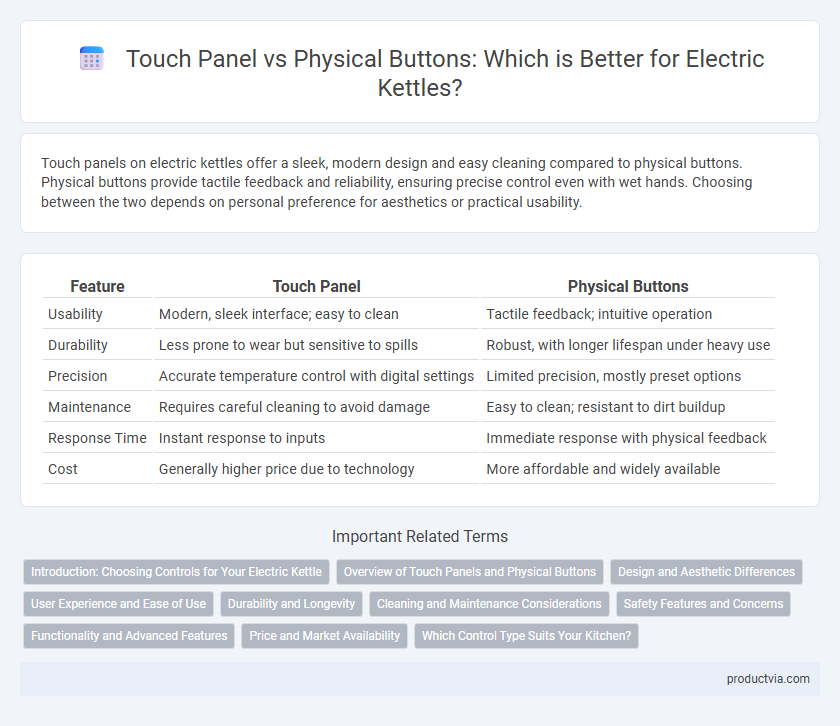Touch panels on electric kettles offer a sleek, modern design and easy cleaning compared to physical buttons. Physical buttons provide tactile feedback and reliability, ensuring precise control even with wet hands. Choosing between the two depends on personal preference for aesthetics or practical usability.
Table of Comparison
| Feature | Touch Panel | Physical Buttons |
|---|---|---|
| Usability | Modern, sleek interface; easy to clean | Tactile feedback; intuitive operation |
| Durability | Less prone to wear but sensitive to spills | Robust, with longer lifespan under heavy use |
| Precision | Accurate temperature control with digital settings | Limited precision, mostly preset options |
| Maintenance | Requires careful cleaning to avoid damage | Easy to clean; resistant to dirt buildup |
| Response Time | Instant response to inputs | Immediate response with physical feedback |
| Cost | Generally higher price due to technology | More affordable and widely available |
Introduction: Choosing Controls for Your Electric Kettle
Touch panels offer a sleek, modern interface for electric kettles with seamless temperature adjustments and easy cleaning, while physical buttons provide tactile feedback and durability under frequent use. Consumers prioritizing aesthetics and customization often prefer touch controls, whereas those valuing reliability and straightforward operation lean towards physical buttons. Selecting the right control type depends on balancing user experience, maintenance preferences, and device longevity.
Overview of Touch Panels and Physical Buttons
Electric kettles with touch panels offer sleek design and easy cleaning, featuring a flat surface that responds to finger taps or swipes for temperature control and settings. Physical buttons provide tactile feedback and durability, commonly preferred for their straightforward operation and reliability in high-heat environments. Both control methods impact user experience and maintenance, with touch panels emphasizing modern aesthetics and physical buttons ensuring practical functionality.
Design and Aesthetic Differences
Touch panels on electric kettles offer a sleek, modern design with smooth surfaces that enhance aesthetic appeal and simplify cleaning. Physical buttons provide tactile feedback and a classic look, often featuring raised, sturdy controls that can complement traditional kitchen styles. The choice between touch panels and physical buttons impacts not only usability but also the overall visual harmony and feel of the kettle in a contemporary or classic kitchen environment.
User Experience and Ease of Use
Touch panels on electric kettles offer a sleek, modern interface with customizable temperature settings but may lack tactile feedback, potentially complicating use for some users. Physical buttons provide immediate, reliable response and are easier to operate without looking, enhancing usability especially for seniors or individuals with limited dexterity. Choosing between touch panels and physical buttons depends on user preference for intuitive tactile interaction versus an advanced, feature-rich control experience.
Durability and Longevity
Touch panels on electric kettles offer sleek design but often sacrifice durability compared to physical buttons, which resist wear and tear from frequent use. Physical buttons typically endure repeated pressing without malfunctioning, extending the kettle's longevity in household environments. Investing in kettles with mechanical controls ensures prolonged functionality and fewer repair needs over years of daily operation.
Cleaning and Maintenance Considerations
Touch panels on electric kettles offer a seamless surface that is easier to wipe clean, minimizing dirt and grime accumulation compared to physical buttons with crevices where dust and water can collect. Physical buttons may require more detailed cleaning with tools like brushes or cotton swabs to prevent buildup and maintain functionality. Choosing a touch panel design can reduce maintenance time and enhance longevity by preventing moisture ingress and mechanical wear.
Safety Features and Concerns
Touch panel electric kettles offer enhanced safety through sealed surfaces that prevent water ingress and reduce electrical hazards, whereas physical buttons may allow moisture to penetrate, increasing the risk of short circuits. Capacitive touch controls often include automatic shutoff features triggered by unintentional touches or overheating, improving user protection. However, physical buttons provide tactile feedback that can prevent accidental activation, ensuring more secure handling, especially in environments prone to spills.
Functionality and Advanced Features
Touch panels on electric kettles offer enhanced functionality with features like precise temperature control, customizable presets, and digital timers, providing users with a modern and intuitive experience. Physical buttons, while simpler, deliver reliable and straightforward operation, often favored for their tactile feedback and durability in everyday use. Advanced touch panel models frequently integrate smart connectivity and LED displays, elevating the electric kettle's usability beyond basic boiling tasks.
Price and Market Availability
Touch panel electric kettles generally come at a higher price point due to advanced technology and sleek design, making them less accessible for budget-conscious consumers. Physical button models dominate the market with widespread availability and affordability, appealing to a broader audience seeking functional and cost-effective options. Market trends show increasing adoption of touch panels in premium segments, while physical buttons remain prevalent in entry-level and mid-range electric kettles.
Which Control Type Suits Your Kitchen?
Touch panels on electric kettles offer sleek, modern aesthetics and easy cleaning, ideal for minimalist kitchens and tech-savvy users. Physical buttons provide tactile feedback and reliable functionality, suited for users valuing durability and straightforward operation. Choosing between touch panels and physical buttons depends on your kitchen style, user preferences, and durability requirements.
Touch panel vs physical buttons for electric kettle Infographic

 productvia.com
productvia.com